Alan Cathcart | March 1, 2019
Alan Cathcart’s 2019 Triumph Speed Twin review takes him on a 170-mile ride through the mountains on the Island of Mallorca.
Check out Triumph’s ever-growing Bonneville family of Modern Classics, and, until now, you’d have found 11 different versions currently available of the British manufacturer’s iconic parallel-twin range, which was resurrected back in 2000 by company owner John Bloor.
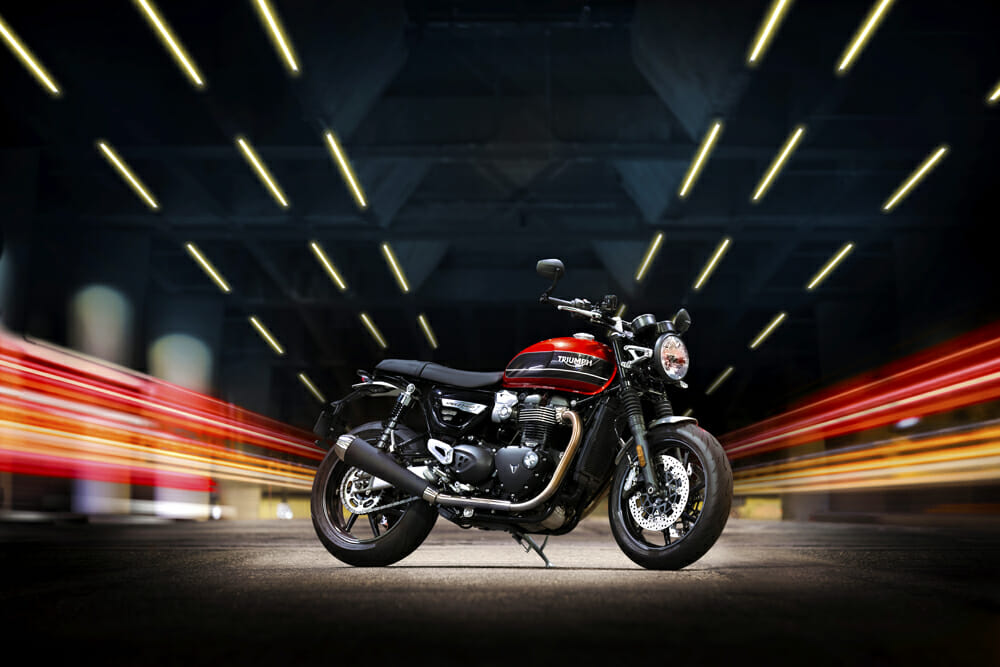 The latest in a very long line, the Speed Twin is lighter and faster than ever before, but still retains its unmistakable character.
The latest in a very long line, the Speed Twin is lighter and faster than ever before, but still retains its unmistakable character.
Since then, no fewer than 313,994 examples of the born-again Bonneville have been produced, making up around 40 percent in any given year of Triumph’s production at its two factories in the UK and three in Thailand. So that makes it a key ingredient in the modern-day success story that Triumph Motorcycles represents.
But now Triumph has gone back to the future in making it an even-dozen different variants in its 2019 Bonneville lineup, with the unveiling last December of an all-new addition to its range of Bloor-era Bonnevilles.
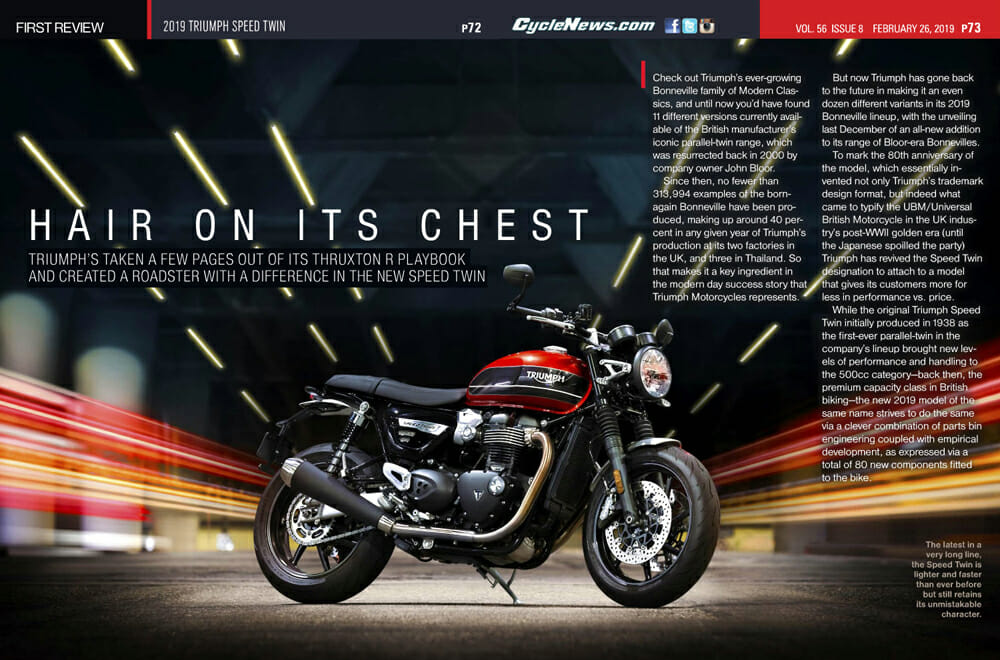
Photography by Kingdom Creative
For to mark the 80th anniversary of the model, which essentially invented not only Triumph’s trademark design format, but indeed what came to typify the UBM/Universal British Motorcycle in the UK industry’s post-WWII golden era (until the Japanese spoiled the party) Triumph has revived the Speed Twin designation to attach to a model that gives its customers more for less in performance vs. price.
While the original Triumph Speed Twin, initially produced in 1938 as the first-ever parallel-twin in the company’s lineup, brought new levels of performance and handling to the 500cc category—back then, the premium capacity class in British biking—the new 2019 model of the same name strives to do the same via a clever combination of parts-bin engineering coupled with empirical development, as expressed via a total of 80 new components fitted to the bike.
The chance to ride the result on a grueling but enjoyable 170-mile test day spent bisecting the mountainous Spanish Balearic Island of Mallorca via the demanding roads, where local hero Jorge Lorenzo honed his three-time MotoGP world-title-winning skills, provided an insight into Triumph’s ambitions in creating the new bike—and whether they’ve been achieved.
You immediately sense substantial improvements in the Speed Twin’s overall performance once you leave city streets—where the light-action cable-actuated slip/assist slipper-type clutch and precise shift action of the six-speed gearbox make coping with traffic completely unstressful, especially on your left hand—and head for the hills.
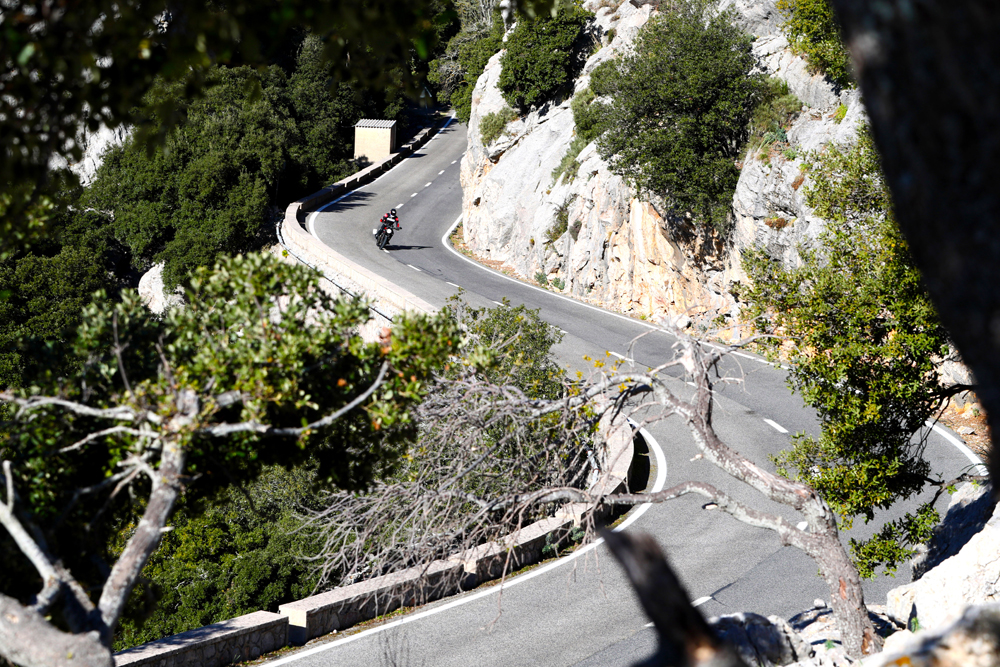 Carving through the Majorcan canyons showed Wood and Co. did a fine job with the new Speed Twin.
Carving through the Majorcan canyons showed Wood and Co. did a fine job with the new Speed Twin.
That comes after throwing your leg over the same flat, low 31.7-inch tall bench seat as the Thruxton, but with 10mm of extra padding, to find the footpegs have been moved 4mm lower and 38mm further forward to deliver a more relaxed riding position in conjunction with the repositioned aluminum taper-section handlebar mounted on taller risers. This makes for a much more comfortable stance than on the Thruxton, which your wrists will be thankful for. Although with the revised footpeg location, I’d have liked the seat to be a little taller—at 5’10” in height, my knees got a bit cramped during a seven-hour day spent chasing the wheel tracks of—no, not Jorge Lorenzo, but someone with a different kind of riding expertise, two-time Isle of Man TT winner Gary Johnson. But shorter riders will find the Speed Twin a very accessible ride, with the shape of the seat aiding them in putting both feet on the floor at rest.
However, height has nothing to do with the enticing accessibility of the Speed Twin’s engine performance, because quite simply this is a T120 Bonneville on steroids, a.k.a. a more rational version of the Thruxton R, and then some. A look at the power and torque curves shows you what to expect, because revs are almost irrelevant on this ultra-muscular, meaty yet mighty variant of the Bonneville motor. It pulls wide open in top gear from 2000 rpm, but with a practically flat torque curve all the way to the 7500-rpm soft-action limiter, as shown on the nicely updated retro-style tacho mounted alongside its speedo sister.
The exhaust note from the good-looking tapered megaphone-style cans matches the performance, with a lovely throbbing beat that’s the closest thing yet on a modern-generation Bonneville let’s-pretend-I’m-a-V-twin engine with its 270° crank to a trad-Dad 360° parallel-twin Triumph of yesteryear.
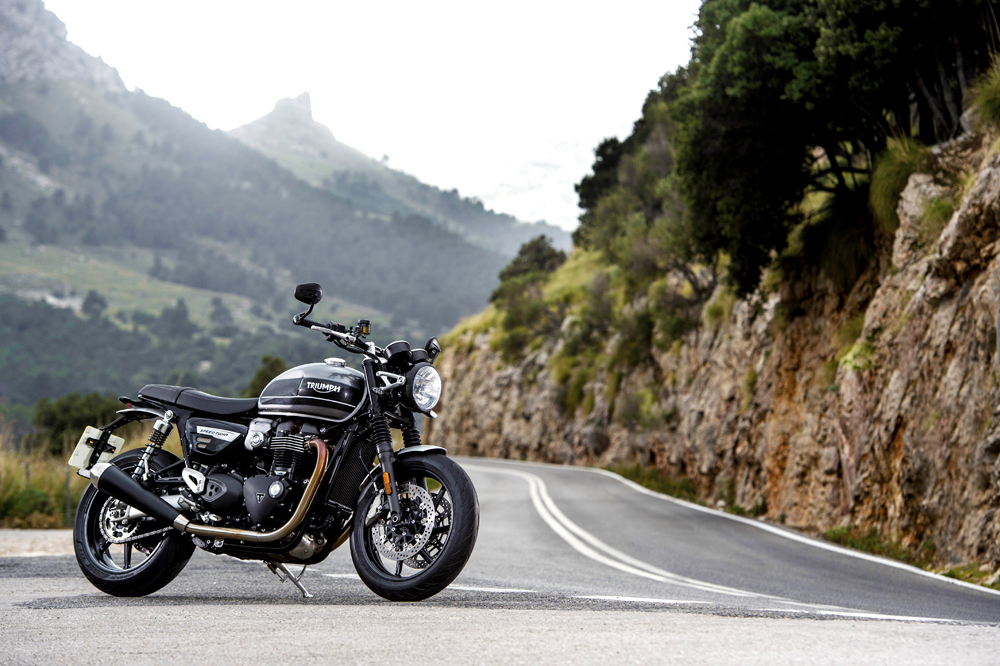 Grey isn’t as flashy as the red, but it’s still a looker.
Grey isn’t as flashy as the red, but it’s still a looker.
But the result is a motor with real mumbo, and presumably aided by the lighter weight, acceleration is definitely impressive all the way through the rev-band in Sport mode, the most zestful out of the three available via the Keihin ECU’s RBW throttle program. But it’s not so bad in Road, either, which you’ll want to use if the pretty aggressive throttle response in Sport isn’t to your liking, given prevailing road and traffic conditions. Though we had glorious winter sunshine throughout our chilly 59° riding day, I found Rain really good for town work, as well as coping with slippery surfaces faintly coated with green on roads up in the hills that are lightly used in the tourist off-season.
Each mode delivers full power, but with different throttle and fuel maps, and features varying degrees of ABS (developed in conjunction with Continental) and TC intervention—I could feel both those rider aids cutting in nice and early in Rain mode on the slippery green stretches of Majorcan tarmac. You can easily switch between modes on the move by thumbing the M-button on the left control pod, and there is indeed quite a noticeable difference between the three. However, you have to really peer at the small marking in the speedo’s digital panel to decipher which mode you’re in – and, yes, I had my glasses on! Make it bigger please, Triumph.
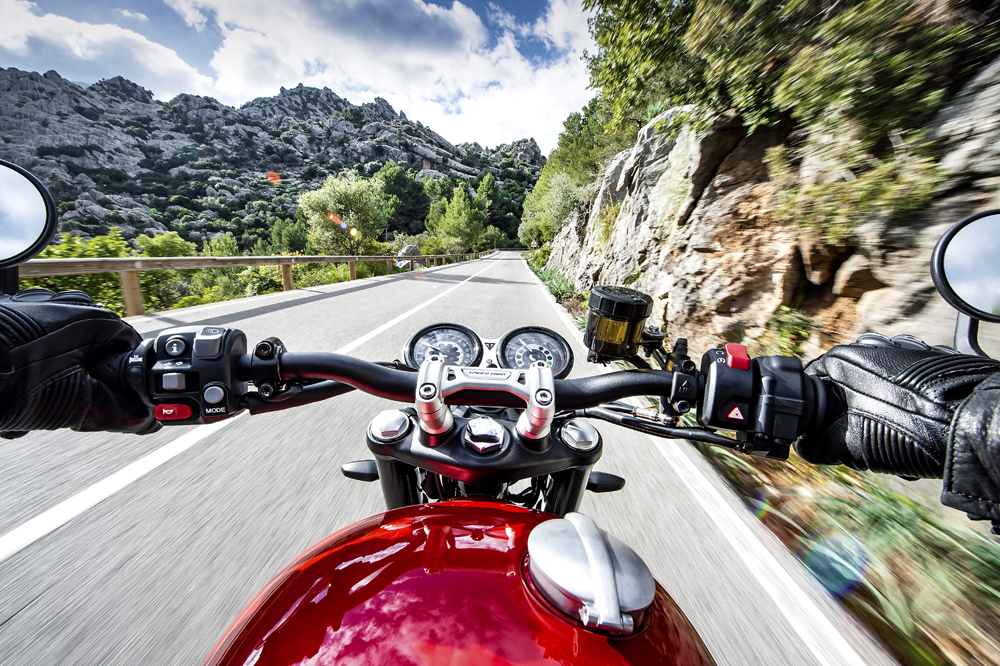 Rider’s view is uncluttered and relaxing. Just you and the road.
Rider’s view is uncluttered and relaxing. Just you and the road.
There’s really great top gear roll-on between 5000-7500 rpm when, even at higher revs, the Speed Twin just keeps on pulling. Ton-up (100 mph) cruising at 5600 rpm is a definite option, and despite the taller handlebar compared to the Thruxton, you don’t get so badly windblown at such high speeds, thanks to the slightly inclined stance it delivers.
But swinging from side to side through a switchback succession of fourth-gear bends is the Speed Twin’s natural habitat, before clicking into top for longer straight stretches. There, 4000 rpm in top gear equals 60 mph, and anything upwards of that makes a nice relaxed cruising speed for this Modern Classic. Really, this is an accessible and thoroughly enjoyable motorcycle which just asks to be ridden hard, and delivers when you do—although a wide-open powershifter would be welcome to help keep it revving hard, even with the lighter crankshaft.
Indeed, the handling on this bike is a really noticeable step up from any other Triumph twin, and please believe that I’m not just saying that because I think I ought to, after hearing Steve Sargent tell me what to expect.
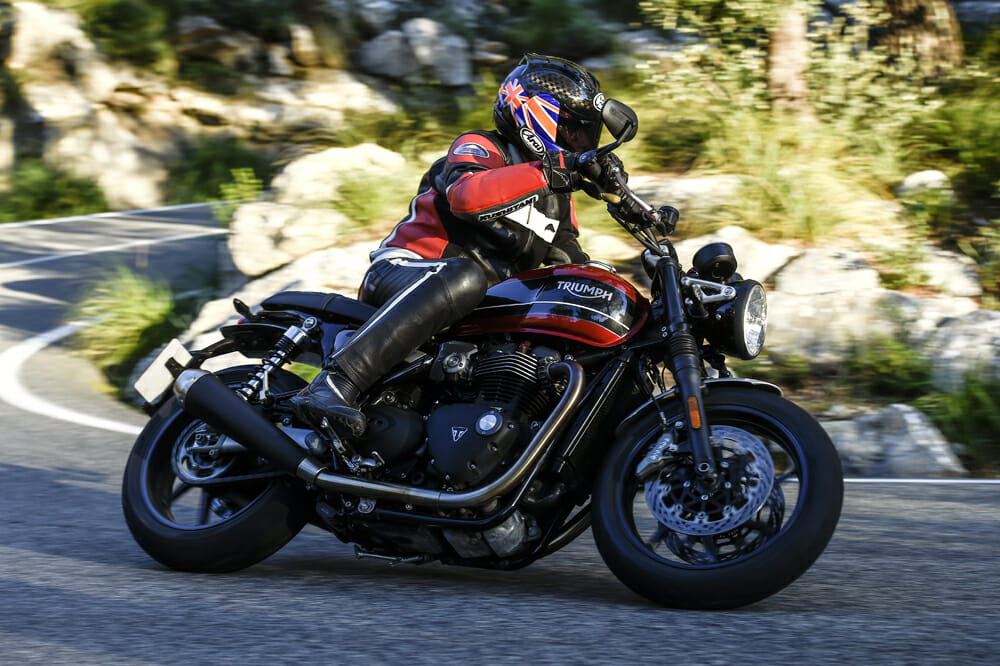 The new Speed Twin hunts corner apexes, especially with the greater agility from the lighter wheels.
The new Speed Twin hunts corner apexes, especially with the greater agility from the lighter wheels.
You honestly do notice the lighter steering and easier change of direction immediately, as soon as you start swinging from side to side through any tight sections of road—it has an eager, willing feel to the handling, aided by the comparatively narrow 160/60-17 rear tire, which inevitably helps deliver agility. Yet when you round a turn to find a family of goats milling around in the middle of the road, the four-piston four-pad Brembo axial (meaning non-radial) calipers fitted to the 305mm Sunstar twin front discs do an excellent job in delivering a controllable but effective panic stop, without any instability. I didn’t miss the extra bite from a radial setup at all—these calipers are a big improvement on what Triumph used before, not only in effectiveness but also in the way you can modulate them just to throw off a little excess speed if you, ahem, misjudge your entry speed for a bend.
The ABS does cut in quite late, so you can be pretty aggressive in using the brakes, plus the top level Pirelli Diablo Rosso III tires fitted to the bike give mega grip, both in helping maintain turn speed—even with the meaty torque, this is much more than a point-and-squirt motorcycle – as well as helping maximize the potential of the brake package. As usual, even in the cool conditions for our ride, the Pirellis heated up super quickly after a stop, an important confidence booster on a bike like this, which entices you to go for it from the very first moment—an attitude Mr. Johnson was a key factor in promoting.
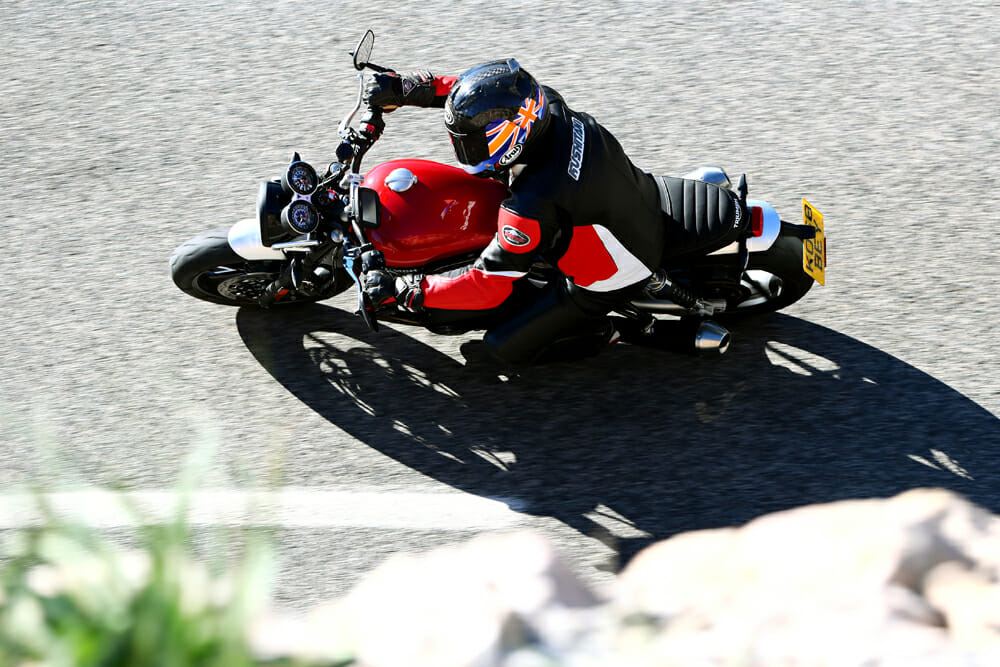 Svelte and nimble has always been the Speed’s trademark. It was Alan’s, too, once upon a time.
Svelte and nimble has always been the Speed’s trademark. It was Alan’s, too, once upon a time.
The new Speed Twin is essentially a more comfortable, more rational version of the Thruxton, and the settings chosen for the KYB forks and twin rear coil-over shocks adjustable only for spring preload are a key element of that. Too bad if you wanted to fiddle with the suspension, but you really don’t need to, because Wood & Co. have done a great job in hitting on an ideal setup. They’ve kept the same spring rates as on the Thruxton, but with less rear preload and a higher oil level on the front, for slightly different fork damping. Coupled with the great grip from the front Pirelli, the result encourages you to keep up turn speed to what at first appears an improbable degree, and coupled with excellent ride quality the result is hard to fault on all but the most uneven of surfaces where the rear end does skip about a little.
And the quite aggressive steering geometry doesn’t deliver any instability, just totally predictable, confidence-inspiring steering. This is a really fun bike to ride hard in something approaching anger, and I reckon it might well surprise quite a few outwardly more sporty-seeming bikes at track days, where its retro styling compared to the Thruxton might cause some to underestimate its sporting potential. At their peril.
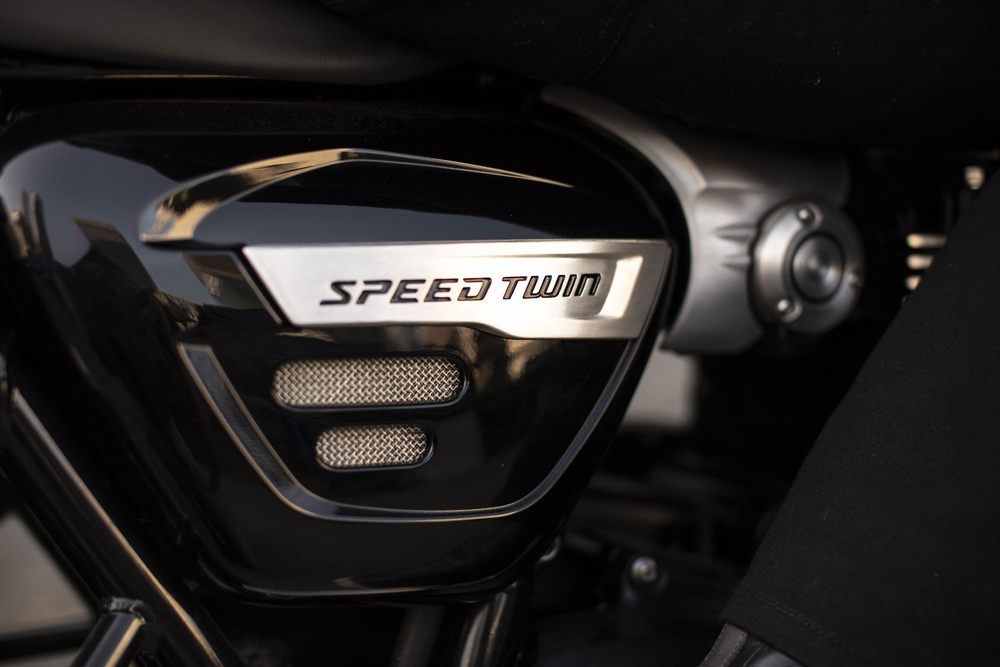 Attention to detail is lovely on the Speed.
Attention to detail is lovely on the Speed.
Eighty years on from the debut of its grandfather, the new Triumph Speed Twin won’t play as crucial a role in reinventing the naked sportbike as its illustrious namesake ancestor did in changing the face of motorcycling—whatever Triumph may claim in their somewhat overwrought PR poop. But it does very arguably set a new standard for all-round performance in the increasingly crucial Modern Classic category, where the costlier BMW RnineT and Ducati 1100 Scrambler are very legitimate targets for the new British bike, whose array of over 80 dedicated accessories will allow any customer to pimp their Speed Twin by using Triumph’s own options catalog. Butch-looking and purposeful, it more than lives up to the expectations aroused by those looks—and at the right price, too. Improbable as it may seem thanks to the retro styling, this is quite enough motorcycle in real-world terms to satisfy all but the hardest of hard-core performance addicts—and it not only goes better than Triumph’s previous top twin, the Thruxton R, it’s also a lot more comfortable to spend a day with.
Job well done, Triumph, but do you really expect anyone to buy a T120 from now on? CN
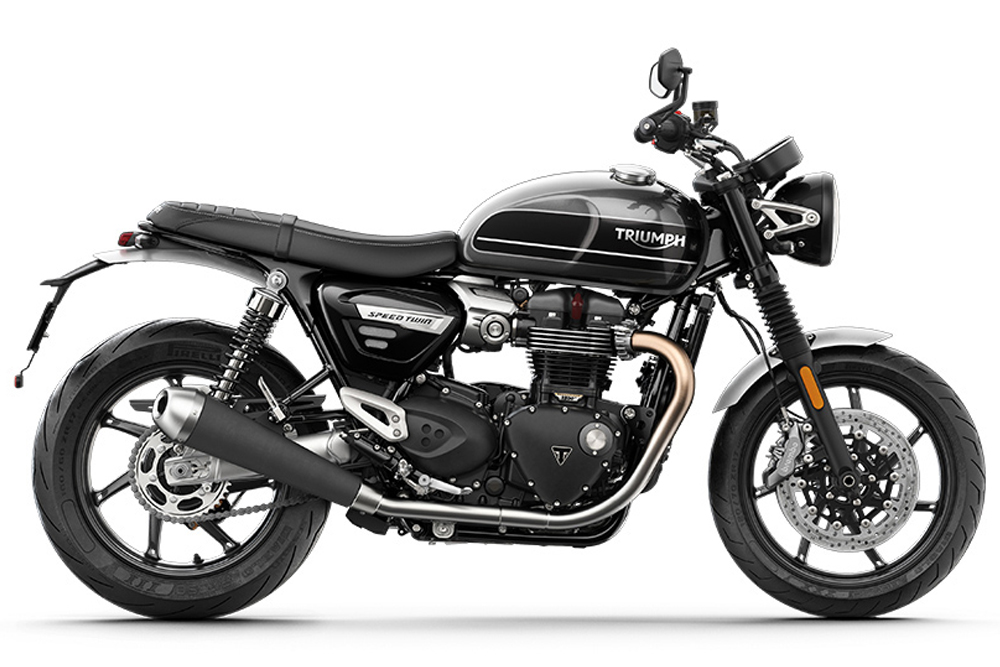
2019 Triumph Speed Twin Specifications
| MSRP: |
$12,100 |
| Engine: |
Liquid-cooled, 8-valve, SOHC, 270° crank angle, parallel twin |
| Displacement: |
1198cc |
| Bore x stroke: |
97.6 x 80mm |
| Compression ratio: |
11.0:1 |
| Clutch: |
Wet, multi-plate assist clutch |
| Transmission: |
6-speed |
| Front suspension: |
41mm cartridge forks |
| Rear suspension: |
Twin shocks with adjustable preload |
| Front wheel travel: |
4.7 in. |
| Rear wheel travel: |
4.7 in. |
| Front brake: |
Twin 305mm discs, Brembo 4-piston fixed calipers, ABS |
| Rear brake |
Single 220mm disc, Nissin 2-piston floating caliper, ABS |
| Front tire: |
120/70-17 in. |
| Rear tire: |
160/60-17 in. |
| Wheelbase: |
56.2 in. |
| Seat height: |
31.7 in. |
| Fuel capacity: |
3.8 gal. |
| Weight: |
432 lb. (dry, claimed). |
| Color: |
Red, grey |